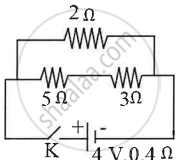Advertisements
Advertisements
प्रश्न
Name three factors on which resistance of a given wire depends and state how is it affected by the factors stated by you.
उत्तर
The following factors can affect a wire's resistance:
- Length of wire: The resistance increases as the wire length increases. R ∝ (l) (directly proportional).
- Area of cross-section (a): The area of the cross-section has an inverse relationship with resistance. For example, the resistance of a thick wire is lower than that of a thin one.
- Temperature (T): As the temperature rises, the resistance of the wire also rises.
APPEARS IN
संबंधित प्रश्न
How does the resistance of a wire depend on its length? Give a reason for your answer.
Draw a I–V graph for a linear resistor. What does its slope represent?
Assertion (A): Copper is used to make electric wires.
Reason (R): Copper has very low electrical resistance.
The effective resistance of three resistors connected in series is lesser than the lowest of the individual resistances.
The resistance of a straight conductor is independent of ______.
The resistance of a conductor is R. If Its length is doubled, then its new resistance will be ______.
The process of conduction of electric current through the solution is called ______.
Match the following:
| Column I | Column II | ||
| 1. | Resistor | a. | Galvanometer |
| 2. | Connecting wire | b. | Voltmeter |
| 3. | Current in an electric circuit | c. | Copper |
| 4. | Potential difference | d. | Constantan |
Define the following:
One ohm
Observe the given circuit diagram and answer the questions that follow:

- Calculate the resistance of the circuit when the key K completes the circuit.
- Calculate the current through 3Ω resistance when the circuit is complete.
